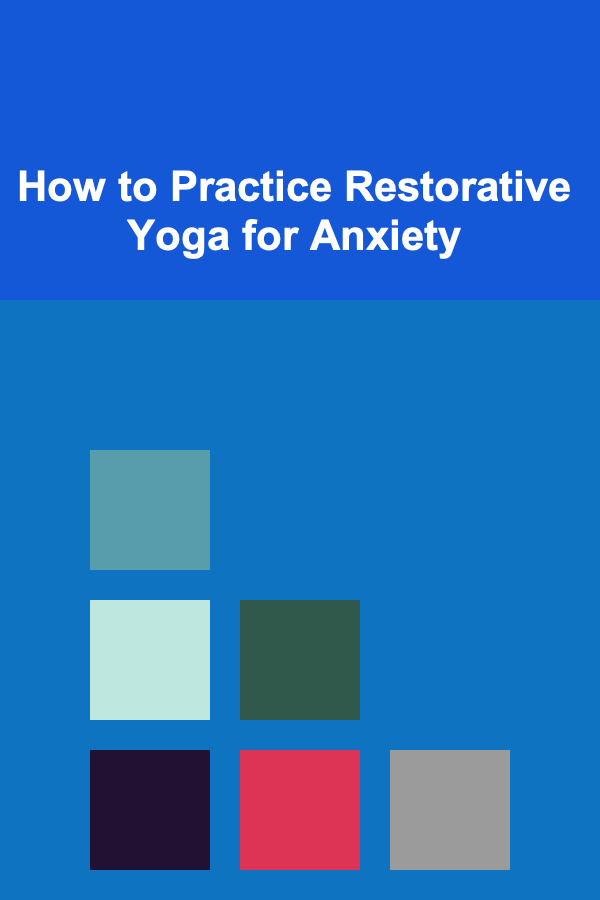
How to Practice Restorative Yoga for Anxiety
ebook include PDF & Audio bundle (Micro Guide)
$12.99$8.99
Limited Time Offer! Order within the next:

Anxiety is a common mental health condition that can significantly impact one's life, from daily activities to physical health. While medication and psychotherapy are widely recognized approaches, many individuals are turning to alternative methods to manage and alleviate anxiety, one of the most effective being restorative yoga.
Restorative yoga is a gentle, healing practice that focuses on relaxation, stress relief, and deep stretching. Unlike more intense forms of yoga, restorative yoga is slower-paced and involves holding poses for extended periods, often supported by props like blankets, bolsters, and blocks to ensure comfort and ease. The aim is to activate the parasympathetic nervous system, which helps the body enter a state of deep relaxation, counteracting the stress response associated with anxiety.
In this article, we will explore how to practice restorative yoga specifically for anxiety, discussing the benefits, key poses, and techniques that will help you manage anxiety and promote emotional well-being.
What is Restorative Yoga?
Restorative yoga is a slow-paced practice that focuses on healing through relaxation and deep breathwork. It involves holding poses for an extended period (typically 5 to 20 minutes) to support the body's natural ability to relax and heal. The poses are typically done on the floor, supported by props such as blankets, bolsters, and blocks to ensure comfort and ease. The goal is to release tension in the body, calm the mind, and reduce stress.
Unlike more dynamic yoga styles like Vinyasa or Ashtanga, restorative yoga is not about achieving physical postures or increasing flexibility. Instead, it's about surrendering and allowing the body and mind to rest, fostering a sense of peace and well-being.
This practice is especially beneficial for individuals experiencing anxiety, as it helps activate the parasympathetic nervous system, which counteracts the fight-or-flight response and induces a state of deep relaxation.
The Connection Between Yoga and Anxiety
Anxiety often results in a constant state of heightened stress, leading to both mental and physical symptoms such as racing thoughts, shallow breathing, muscle tension, and increased heart rate. When you practice restorative yoga, you can activate the parasympathetic nervous system, which promotes relaxation by lowering the heart rate, relaxing the muscles, and calming the mind.
Yoga has long been known to be an effective practice for anxiety management. Here are a few reasons why yoga, especially restorative yoga, can be helpful:
1. Regulation of Breathing
One of the main focuses in restorative yoga is breathwork. The deep, slow breaths used in this practice activate the parasympathetic nervous system, which helps calm the body's stress response. By practicing controlled breathing, you can quickly lower your heart rate, release tension, and regulate your emotions. Deep breathing also helps reduce the rapid, shallow breathing often associated with anxiety.
2. Mindfulness and Present Moment Awareness
Restorative yoga encourages mindfulness, a practice of staying present and focused on the moment. Anxiety often arises from worrying about the future or ruminating on the past, but by focusing on your breath and the sensations in your body, you can shift your attention away from anxious thoughts and into the present.
3. Reduction of Physical Tension
Anxiety can lead to physical symptoms, such as muscle tightness, headaches, and body aches. The deep, gentle stretching in restorative yoga releases tension in the body, promoting relaxation and reducing discomfort. Holding poses for extended periods allows the body to fully relax and release stored tension.
4. Emotional Release
Sometimes, emotional tension is stored in the body, and restorative yoga can help release this tension. As you hold poses and focus on your breath, you may notice emotional shifts or feelings of release. This emotional release can be therapeutic, helping to reduce feelings of anxiety and promote emotional well-being.
How to Practice Restorative Yoga for Anxiety
If you're new to restorative yoga, don't worry---this practice is designed to be accessible and approachable. Here's a step-by-step guide to help you get started:
1. Set the Stage for Relaxation
Before you begin your practice, it's important to create a peaceful environment. Choose a quiet space where you can practice without distractions. Dim the lights, play calming music if you'd like, and use props to make yourself comfortable. You'll need blankets, pillows, and yoga blocks to support your practice.
Ensure you are dressed in comfortable clothing, allowing for free movement and relaxation. Consider using a soft mat or blanket on the floor to enhance your comfort during the practice.
2. Start with a Gentle Breathing Practice
Begin your restorative yoga session with a gentle breathing exercise. This can help calm the mind and prepare your body for deeper relaxation. A simple breathwork technique is diaphragmatic breathing or belly breathing.
Belly Breathing:
- Sit or lie down comfortably with your hands resting on your belly.
- Inhale deeply through your nose, allowing your belly to rise and expand as you breathe in.
- Exhale slowly and completely, letting your belly fall.
- Continue to breathe slowly and deeply for 3-5 minutes, focusing on the sensation of your breath moving in and out.
As you breathe, try to clear your mind of distractions and focus solely on the breath.
3. Use Props for Support
Restorative yoga relies heavily on props to ensure that the body is fully supported and comfortable in each pose. Common props include bolsters, blankets, pillows, and blocks. These props help you relax deeper into the poses without straining your muscles.
If you don't have yoga props, you can improvise with household items like cushions, towels, or pillows. The key is to make sure that your body feels supported and comfortable so you can fully relax and release tension.
4. Start with Supported Child's Pose (Balasana)
Child's pose is a foundational restorative yoga pose that helps calm the nervous system and release tension in the back, hips, and shoulders. This pose is ideal for beginners and can be held for extended periods (5--10 minutes).
How to do Supported Child's Pose:
- Kneel on the mat with your big toes touching and knees wide apart.
- Place a bolster or cushion between your legs and gently fold forward, resting your forehead on the bolster.
- Extend your arms in front of you or rest them by your sides, whichever feels most comfortable.
- Breathe deeply and relax in the pose, allowing your body to release tension with each exhale.
This simple yet effective pose helps calm the body and mind, promoting deep relaxation.
5. Practice Supported Savasana
Savasana (Corpse Pose) is typically the final resting pose in a yoga practice, but it's also an excellent pose to incorporate into restorative yoga sessions for anxiety. This pose encourages complete relaxation and mindfulness.
How to do Supported Savasana:
- Lie down on your back, with your legs extended and arms by your sides.
- Place a bolster under your knees to relieve any lower back tension, or place a blanket or cushion under your head for added support.
- Close your eyes and focus on your breath, allowing your body to soften into the mat.
- Stay in the pose for 10--15 minutes, allowing your body to relax deeply.
As you lie in Savasana, let go of any lingering tension or stress, and simply be present with your breath and the sensations in your body.
6. Incorporate Other Restorative Poses
Here are some additional restorative poses that can be beneficial for managing anxiety:
- Supported Forward Fold (Uttanasana): Sit on the floor with your legs extended straight out in front of you. Place a bolster or pillow on your legs and gently fold forward, allowing your body to relax over the prop.
- Reclining Bound Angle Pose (Supta Baddha Konasana): Lie on your back with your legs in a V-shape, soles of the feet touching. Place props under your knees for support, and relax with your hands on your belly or by your sides.
- Legs Up the Wall (Viparita Karani): Sit next to a wall and extend your legs up the wall while lying on your back. This pose helps to calm the nervous system and reduce stress.
Each of these poses can be held for 5--15 minutes, depending on your comfort level. Always prioritize comfort and relaxation, and feel free to modify the poses with props as needed.
7. End Your Practice with Gratitude
Once you've completed your restorative yoga session, take a few moments to reflect on your practice. You can do this by setting an intention for peace, calming your mind, and expressing gratitude for the time you've taken to nurture yourself.
Final Thoughts
Restorative yoga is an effective and gentle practice that can help individuals manage anxiety, reduce stress, and promote emotional well-being. By incorporating deep breathing, mindfulness, and soothing postures, restorative yoga encourages the body and mind to relax, counteracting the fight-or-flight response triggered by anxiety.
If you're new to restorative yoga, be patient with yourself. This practice is about relaxation and self-care, not achieving perfection. With consistent practice, restorative yoga can become a powerful tool in managing anxiety and promoting a sense of calm in your daily life.
The key to practicing restorative yoga for anxiety is to listen to your body, use props for support, and allow yourself to fully relax in each pose. Through this practice, you can cultivate a sense of peace, balance, and emotional resilience that will carry over into all aspects of your life.
Reading More From Our Other Websites
- [Home Renovating 101] How to Waterproof Your Basement: A Step-by-Step Guide
- [Home Renovating 101] How to Build and Renovate a Deck: Step-by-Step Guide
- [Personal Care Tips 101] How to Use Hair Serum to Maintain Healthy Hair During Winter
- [Home Renovating 101] How to Transform Your Garage Renovation Projects into Extra Living Space
- [Home Holiday Decoration 101] How to Style Your Christmas House Window Decorations
- [Home Staging 101] How to Style and Arrange Furniture to Make a Small Room Look Bigger in Your Listing Photos
- [Polymer Clay Modeling Tip 101] How to Build a Portable Polymer Clay Studio for On‑The‑Go Artists
- [Organization Tip 101] What Techniques Can Help You Organize Your Workspace at Home?
- [Skydiving Tip 101] The Science Behind Freefall: How Altitude Impacts Speed and Duration
- [Metal Stamping Tip 101] Choosing the Right Deburring Method for Different Metals and Stamping Applications

How to Avoid Common Mistakes in Hobby Organization
Read More
How to Create a Focal Point in Any Room Without Expensive Decor
Read More
How to Create a Functional Mudroom in Your Home Renovation
Read More
How to Incorporate Statement Art Pieces in Home Staging
Read More
How to Opt-Out of Credit Card Pre-Approved Offers
Read More
How to Photograph Landscapes While Hiking
Read MoreOther Products

How to Avoid Common Mistakes in Hobby Organization
Read More
How to Create a Focal Point in Any Room Without Expensive Decor
Read More
How to Create a Functional Mudroom in Your Home Renovation
Read More
How to Incorporate Statement Art Pieces in Home Staging
Read More
How to Opt-Out of Credit Card Pre-Approved Offers
Read More